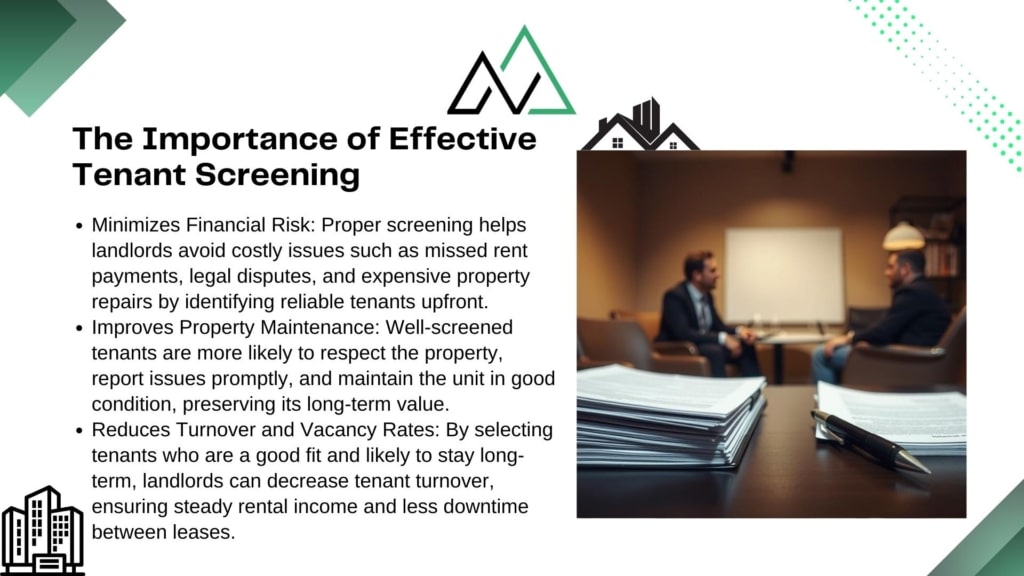Did you know that a single bad tenant can cost a landlord thousands of dollars in damages and lost rental income? Effective tenant screening is crucial for protecting your property investment.
New Homes Alberta, with years of expertise in property management, has put together this comprehensive guide to walk you through the essential steps of evaluating rental applications. From pre-screening questions to formal verification methods, we’ll cover the legal and practical aspects of finding reliable tenants.
By following this guide, you’ll be able to make informed decisions while remaining compliant with Canadian tenancy laws. For more information or assistance, you can contact New Homes Alberta at (403)305-9167.
Key Takeaways
- Understand the importance of tenant screening for landlords.
- Learn the essential steps involved in evaluating rental applications.
- Discover tools and techniques to improve your tenant selection process.
- Gain insights into Canadian tenancy laws and how to remain compliant.
- Develop a systematic approach to property management.
The Importance of Effective Tenant Screening

The key to a successful landlord-tenant relationship lies in a comprehensive screening process. As a landlord, it’s essential to invest time in vetting potential tenants to ensure they’re a good fit for your rental property.
Why Screening Matters for Your Investment Property
Effective tenant screening serves as the first line of defense for protecting your investment property from potential damage, unpaid rent, and legal complications. By implementing a thorough screening process, landlords can significantly reduce the risk of encountering problematic tenants. New Homes Alberta has observed that properties with well-screened tenants maintain their value better and require less management intervention over time.
- A comprehensive screening approach helps identify tenants who will treat your property with respect and pay rent consistently.
- Landlords who implement thorough screening processes typically experience fewer issues with tenant turnover and property damage.
- Professional screening processes help landlords identify red flags early, preventing costly mistakes in tenant selection.
The Cost of Poor Tenant Selection
The financial impact of poor tenant selection extends beyond missed rent payments to include legal fees for eviction, property repairs, and extended vacancy periods between tenants. The time invested in proper screening is minimal compared to the potential months of dealing with problematic tenants and the associated financial losses. By taking the necessary steps to verify the information provided on rental applications, landlords can avoid these costly consequences.
For more information on effective tenant screening or to discuss your specific needs, you can contact New Homes Alberta at (403)305-9167.
Understanding Legal Considerations in Canada

Landlords in Canada must navigate a complex legal landscape when screening potential tenants. This involves understanding and complying with various provincial tenancy laws, privacy regulations, and anti-discrimination laws.
Provincial Tenancy Laws in Alberta
In Alberta, landlords must familiarize themselves with the province’s unique legal framework governing tenant screening. This includes understanding the requirements for application processes, security deposits, and lease agreements. For instance, Alberta’s residential tenancy legislation outlines specific guidelines that landlords must follow when screening tenants.
- Understand the Residential Tenancies Act and its implications
- Familiarize yourself with the specific requirements for security deposits
Privacy Regulations and Information Protection
Privacy regulations, particularly PIPEDA (Personal Information Protection and Electronic Documents Act), play a crucial role in governing how landlords collect, use, and store applicants’ personal information. Landlords must obtain proper written consent before conducting credit checks or background checks.
Avoiding Discrimination in the Screening Process
Discrimination laws prohibit landlords from rejecting applicants based on protected characteristics such as race, religion, family status, or disability. To comply, landlords must ensure their screening criteria are objectively related to tenancy performance. New Homes Alberta emphasizes the importance of maintaining fairness and transparency throughout the screening process. For more information or guidance, you can contact New Homes Alberta at (403)305-9167.
- Develop clear, objective screening criteria
- Apply the same criteria to all applicants
By understanding and adhering to these legal considerations, landlords can ensure a fair and compliant tenant screening process.
How to Screen Tenants: The Step-by-Step Process

Landlords can minimize risks by implementing a thorough tenant screening process. This process involves several key steps that help landlords make informed decisions about potential tenants.
Pre-Screening Potential Applicants
Pre-screening is the first step in the tenant screening process. It begins with creating a transparent rental listing that clearly outlines your expectations. This helps discourage unqualified applicants from applying. For instance, you can state that applicants must submit a rental application and consent to a credit check. New Homes Alberta recommends conducting initial phone interviews to assess basic compatibility and explain your screening process before scheduling in-person property viewings.
During these interviews, ask questions about the applicant’s move-in timeline, reasons for relocating, and willingness to undergo credit checks. This initial screening helps filter out unsuitable applicants before investing significant time in property showings and application reviews.
Creating a Comprehensive Rental Application
A comprehensive rental application form is the foundation of your screening process. It collects essential information about the applicant’s rental history, income, employment, and references. The application should include authorization for background checks, credit reports, and reference contacts, with clear explanations of how this information will be used.
Using the same rental application for all prospective tenants ensures that the same information is requested and collected, which may help avoid claims of discrimination.
Setting Clear Tenant Criteria
Setting consistent tenant criteria helps ensure a fair evaluation of all applicants. Focus on factors that predict successful tenancies, such as income stability, rental history, and credit reliability. For landlords managing multiple properties, New Homes Alberta suggests developing standardized screening tools and processes that can be consistently applied across all rental units.
Clear communication about your screening expectations from the beginning helps set a professional tone for the landlord-tenant relationship.
| Criteria | Description | Importance Level |
|---|---|---|
| Income Stability | Applicant’s income level and employment history | High |
| Rental History | Previous rental experiences and references | High |
| Credit Reliability | Applicant’s credit score and history | High |
For more information on tenant screening or to discuss your specific needs, contact New Homes Alberta at (403)305-9167.
Essential Verification Methods for Landlords
Verifying tenant information is a critical step in the rental process that landlords cannot afford to overlook. To ensure they’re making an informed decision, landlords must conduct thorough checks on potential tenants.
Conducting Credit and Background Checks
A comprehensive credit check is a crucial part of the tenant screening process. By using a professional service like FrontLobby, landlords can access a tenant’s financial history, including credit score, payment history, outstanding debts, and any collections or bankruptcies. This information helps landlords assess the risk of renting to a particular tenant. For instance, a tenant with a history of late payments or high levels of debt may be considered a higher risk.
Verifying Employment and Income
Verifying a tenant’s employment and income is essential to ensure they can afford the rent. Landlords should contact the tenant’s employer directly to confirm their employment status, job title, and length of employment. The general rule of thumb is that rent should not exceed 30% of the tenant’s gross monthly income. By verifying income, landlords can gain peace of mind knowing that their tenants have a stable financial situation.
Contacting Previous Landlords and References
Contacting previous landlords and references provides valuable insights into a tenant’s rental history and behavior. Landlords should ask specific questions about the tenant’s payment history, property care, and any issues that arose during the tenancy. This information can help landlords determine whether a tenant is likely to be a good fit for their property.
| Verification Method | Purpose | Key Information |
|---|---|---|
| Credit Check | Assess financial responsibility | Credit score, payment history, outstanding debts |
| Employment Verification | Confirm employment status | Job title, length of employment, income level |
| Previous Landlord References | Evaluate rental history | Payment history, property care, tenancy issues |
By implementing these verification methods, landlords can make informed decisions and minimize the risk of problematic tenants. New Homes Alberta recommends using professional screening services to streamline the verification process and ensure compliance with privacy laws. For more information on tenant screening services, you can contact New Homes Alberta at (403)305-9167.
Red Flags to Watch For During Tenant Screening
Identifying warning signs during the tenant screening process can save landlords from problematic tenancies. Effective tenant screening is crucial for landlords to ensure they’re renting their property to reliable tenants. New Homes Alberta emphasizes the importance of being vigilant during this process to avoid potential issues down the line.
Financial Warning Signs
Credit reports can reveal concerning financial patterns, such as multiple late payments, collections accounts, or high debt-to-income ratios. These indicators suggest potential difficulty in paying rent on time. Landlords should be cautious when they notice such financial red flags during the tenant screening process.
Rental History Concerns
Rental history concerns, including previous evictions, frequent moves, or gaps in rental history, warrant further investigation. New Homes Alberta advises landlords to ask specific questions when contacting a tenant’s current and past landlords, such as whether the tenant paid rent on time and if the property was maintained properly.
Communication and Behavioral Indicators
Communication patterns during the application process often predict future tenant behavior. Evasiveness, reluctance to provide information, or hostility toward screening requirements may indicate potential issues. Additionally, behavioral red flags during property showings, such as disrespect for the property or unreasonable demands, can forecast problematic tenant relationships.
Documentation Inconsistencies
Documentation inconsistencies, such as mismatched addresses, name variations, or discrepancies between stated income and employment verification, often signal deliberate attempts to hide negative information. Landlords should document all red flags objectively and maintain records of why applications were declined to protect against potential discrimination claims.
While a single red flag may not warrant automatic rejection, multiple warning signs across different screening areas should prompt careful reconsideration of the application. Professional property managers develop an intuition for concerning applicant behaviors that often correlate with future tenancy problems. By being thorough in the tenant screening process, landlords can significantly reduce the risk of problematic tenancies.
Conclusion: Building a Successful Landlord-Tenant Relationship
Effective tenant screening is the cornerstone of a successful landlord-tenant relationship. By establishing clear expectations and selecting renters who align with your property management goals, you lay the foundation for a positive and productive tenancy.
New Homes Alberta has found that landlords who invest time in thorough screening processes typically enjoy longer tenancies, fewer conflicts, and more consistent rental income. The screening process should be viewed not just as a filtering mechanism but as the first step in building a positive professional relationship with your future tenant.
To achieve this, it’s essential to have a well-designed tenant screening process in place. This includes creating a comprehensive rental application, setting clear tenant criteria, and verifying potential tenants’ credit and background information. By doing so, you can attract, choose, and retain the best tenants for your property.
For landlords managing multiple properties, developing systematic screening tools and processes creates efficiency while maintaining thoroughness in tenant selection. New Homes Alberta recommends periodic review and refinement of your screening process based on tenancy outcomes to continuously improve your tenant selection. For personalized guidance, contact New Homes Alberta at (403)305-9167.
Ultimately, the goal of tenant screening is not just to avoid bad tenants but to find great ones who will care for your property, pay rent on time, and contribute to a mutually beneficial landlord-tenant relationship.
FAQ
What information should be included in a rental application?
A comprehensive rental application should include personal and contact information, employment and income details, rental history, and consent for credit and background checks.
How do I verify a tenant’s employment and income?
You can verify a tenant’s employment and income by contacting their employer directly, reviewing pay stubs, or using a tenant screening service that provides employment verification.
What are some common red flags to watch for during tenant screening?
Common red flags include poor credit history, inconsistent or unverifiable employment, previous evictions, and negative references from previous landlords.
Can I reject a tenant based on their credit score alone?
While credit score is an important factor, it’s not the only consideration. You should also evaluate other criteria, such as income, rental history, and employment stability, to make an informed decision.
What are the key elements of a compliant tenant screening process?
A compliant tenant screening process involves establishing clear criteria, applying the same standards to all applicants, and maintaining accurate records of the screening process.
How do I ensure compliance with privacy regulations during tenant screening?
To ensure compliance, you should only collect necessary information, store it securely, and obtain applicants’ consent before conducting credit and background checks.
What is the importance of checking a tenant’s rental history?
Checking a tenant’s rental history helps you assess their reliability, payment habits, and potential risks, enabling you to make a more informed decision.
Can I use a tenant screening service to simplify the process?
Yes, tenant screening services can streamline the process by providing access to credit reports, background checks, and other verification tools, helping you make more informed decisions.





